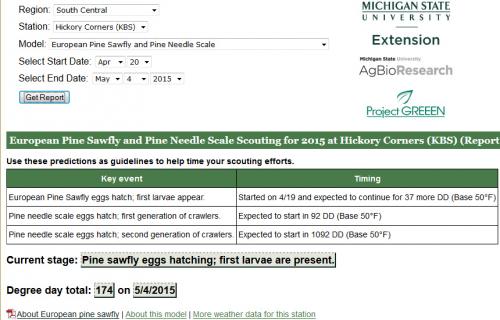Using Enviro-weather to monitor European pine sawflies in Michigan
Monitor growing degree days at a location near you to effectively time preventative spray applications for European pine sawflies.

With Michigan State University’s Enviro-weather system, you can learn about your local weather conditions (precipitation, air and soil temperature, humidity and much more) from one of 81 stations throughout Michigan. From those data, you can look at how many growing degree days (GDD) have accumulated in your area, which is the primary factor affecting pest insect’s development. For example, if you are a Christmas tree grower interested in spraying for European pine sawflies, a pest of Scots, mugo, red, Japanese red, jack and Swiss mountain pines, you could follow this step-by-step guide to monitor its life stage.
- Go to www.enviroweather.msu.edu.
- Click on the station closest to you.
- Click on the Landscape and Nursery tab.
- Click on the Christmas trees folder.
- Under that folder, click on European Pine Sawfly and Pine Needle Scale.
- This screen lists region, station, start and end date of report, current GDD totals and life stage of European pine sawflies.

Landscape and Nursery page for Hickory Corners, Michigan.
In Hickory Corners, Michigan, there was a total of 174 GDD as of May 4, 2015. The model states that European pine sawfly eggs began hatching April 19 and will continue for 37 more GDD. Therefore, a grower scouting for European pine sawflies should be looking for the larvae relatively soon. Michigan State University Extension recommends growers continue to monitor the degree days and pest insect models with MSU’s Enviro-weather system to effectively time spray applications or conduct other pest management practices.

Outlook for European sawfly in Hickory Corners, Michigan on May 4, 2015.
For more information on European pine sawflies, see:
- European Pine Sawfly, A Pocket IPM Scouting Guide for Woody Landscape Plants
- The mystery of missing pine needles: European pine sawfly, MSU Extension
- Check pines now for European pine sawfly larvae, MSU Extension
What is a degree day?
Degree days are a way of measuring heat that is accumulated above a temperature threshold. One growing degree day is equivalent to one degree above that a minimum temperature threshold for one day.
For more information on degree days for Christmas tree pest management and other landscape or conifer insect pests, visit the MSU IPM Growing Degree Day Information page. This page also includes GDD accumulation maps for improving timing in insect pest management.
How do you know what the base temperature is for the pest?
Degree days are reported in reference to a certain minimum temperature, or the base temperature. Below that temperature, the insect does not develop. For European pine sawflies, the base temperature is 50 degrees. Other pests of conifers, including the Cooley spruce gall adelgids and the eastern spruce gall adelgids, also have base temperatures of 50 degrees. In contrast, seed corn maggots, for example, have a base of only 39 degrees.



 Print
Print Email
Email



